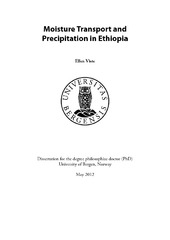| dc.description.abstract | With little irrigation and a diverse climate, Ethiopia is a country where the effects of too little precipitation are frequently seen. While the generation of precipitation also depends on local ascent and cooling of the air, the main focus of this thesis has been on the transport of moisture into the country. Three manuscripts are included. One provides an overview of drought episodes in all parts of Ethiopia during the last decades, while the other two discuss moisture transport as a component of the main rainy season in the northern Ethiopian highlands. In the drought analysis (Paper III), gauge observations were used to construct monthly time series for 14 homogeneous rainfall zones, covering all of Ethiopia during 1971–2010/2011. The Standardized Precipitation Index (SPI) was then calculated for each zone on time scales of 3, 4, 6, 9, 12, 24 and 48 months. The results indicate that 2009 was one of the driest years in Ethiopia since 1971, and that there has been a cluster of dry spring seasons in most of the country during the last 10–15 years. Linear regression analysis confirmed a decline in precipitation in southern Ethiopia, both in the spring and in the summer. The trend analysis did not give us reason to draw any conclusions for central and northern Ethiopia, but the clustering of dry spring seasons during the last 10–15 years was apparent also in this part of the country. For the moisture transport analysis documented in Paper I and Paper II, the Lagrangian trajectory model FLEXPART was used with ERA-Interim reanalysis data as input, to backtrack air parcels from the northern Ethiopian highlands (8–14 °N, 36–40 °E) during July and August 1998–2008. The resulting trajectories show that the transport of air into the region can be seen as the sum of a limited number of branches with distinct moisture characteristics. Most of the moisture is transported into the highlands from the regions to the north, with moisture flowing from the Mediterranean region either above the Red Sea or above the Arabian Peninsula; and from the Indian Ocean, entering directly from the south, or crossing westward into Central Africa before turning northeastward and entering Ethiopia from the west. In addition, there is a distinct, but smaller branch crossing the continent from the Gulf of Guinea. The Indian Ocean and the Red Sea were found to be major sources of moisture, and there is also a considerable uptake of moisture along the routes above equatorial Africa. Moisture entering a region can by no means be seen as a proxy for precipitation. If considering, not just the amount of moisture brought into the Ethiopian highlands, but also the amount of moisture released before the air leaves the region, there is a shift from the northern branch to the southern branches. The inflow of moisture from the north is about 30 % higher than from the south, but the contribution to the amount of moisture released, is roughly equal for air from the north and air from the south. During 1998–2008 the variability in moisture transported by the southern branches, i.e. from the Indian Ocean, Central Africa and the Gulf of Guinea, was associated with precipitation variability of the same sign. During wet/dry summer months, the amount of moisture brought into the highlands from the south was increased/decreased, as was also the release of moisture in the region. Specifically, westerly anomalies in the low-level circulation anomalies above Central Africa were seen to increase the transport from the Gulf of Guinea, and in most cases also from the Indian Ocean. Southerly anomalies along the coast of East Africa were also associated with increasing moisture transport from the Indian Ocean. The amount of moisture brought into the highlands from the north could not be consistently related to changes in precipitation. | en_US |
| dc.relation.haspart | Paper I: Viste, E., Sorteberg, A. (2011) Moisture transport into the Ethiopian highlands. International Journal of Climatology, International Journal of Climatology 33(1): 249–263, January 2013. The article is available at: <a href="http://hdl.handle.net/1956/6260" target="blank">http://hdl.handle.net/1956/6260</a> | en_US |
